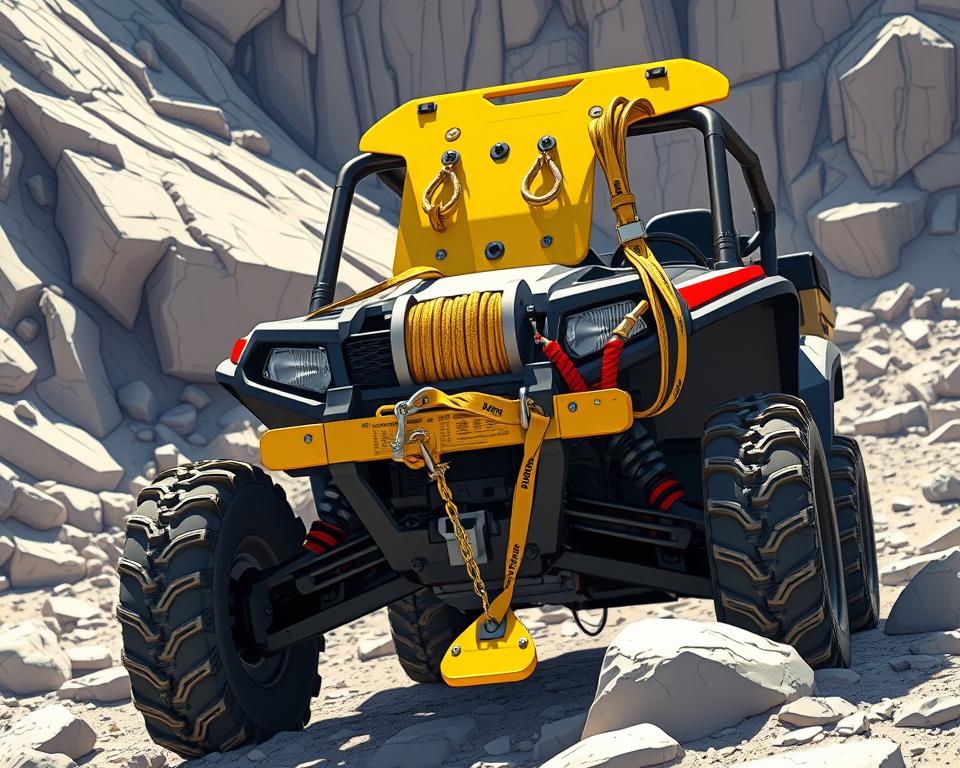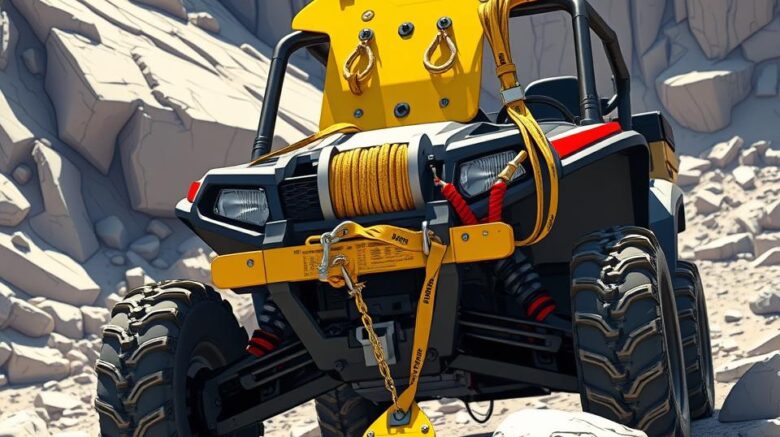Must-Have ATV Off-Road Safety Checklist
Did you realize nearly approaching half a million ATV-related injuries are treated in U.S. emergency rooms each year? That startling statistic underscores why off-road safety and preparation are essential. The Essential ATV Off-Road Checklist is your guide to a safe and enjoyable ride. It covers everything from rocky trails to sand dunes. Armed with proper safety equipment and Can Am defender lift kit must-haves, you’ll reduce hazards and amplify the fun.
Core Lessons
- Use this checklist first to prep safely and thoroughly.
- Your gear list is critical for staying protected off-road.
- Regular maintenance is key to keep your ATV in top shape.
- Water and snacks—musts for long off-road sessions.
- Learn to use navigation tools to avoid getting lost on off-road routes.
- Weather can flip fast—be ready with proper gear.
- Your tool and recovery kit can save the day on the trail.
Understanding the Importance of Safety Gear
When you ride off-road, safety must come first. Riding an ATV is thrilling but comes with risks. Proper gear guards you against mishaps. Being well-equipped ensures a safer ride and follows an ATV safety gear checklist.

Essential Protective Gear
Maximizing protection involves several key items:
- Helmets: Choose DOT-approved helmets to prevent head injuries.
- Eye Protection: Block dirt and grit with quality goggles.
- Gloves: Gloves help you hold on and protect your skin.
- Boots: Ankle-support boots are a must.
- Body Armor: Aggressive riders should consider body armor for extra security.
- Neck Protection: A neck brace protects your spine in a crash.
Emergency Preparedness
Being ready for emergencies is critical. Your emergency bag could be your best friend. Key items to include are:
- First aid kit
- Multi-tool
- Tire repair kits
- Portable air compressors
- Emergency blankets
- Whistles
- Matches
ATV Equipment for Optimal Performance
Gear choices affect how well your ATV runs. Knowing the must-have ATV equipment ensures you’re ready for any journey. Regularly following an ATV maintenance checklist helps maintain your machine’s functionality and longevity.
Must-Have ATV Equipment
- All-Terrain Tires: Invest in tires designed for various terrains to improve traction and handling.
- Cargo Systems: Keep tools and spares within reach.
- Quality Fuel Tank: A high-quality fuel tank prevents leaks and ensures you have enough fuel for extended rides.
- First Aid Kit: Prepare for emergencies with a well-stocked first aid kit for immediate attention if needed.
Regular Maintenance for Longevity
A maintenance schedule is your ATV’s best friend. Regular inspections should encompass:
- A clean air filter = a happy engine.
- A well-lubed chain spins quietly and reliably.
- Inspecting brakes for safety before each ride.
Stay on top of upkeep and your ATV will perform its best.
The Essential ATV Off-Road Checklist
Good prep keeps surprise breakdowns away. An effective ATV maintenance checklist ensures your vehicle’s safety and performance. Each pre-ride inspection step requires attention to detail. Spend a few minutes now for peace of mind later.
Pre-Ride Inspection Basics
Before any off-road journey, a pre-ride inspection is vital. Find and fix small problems before they grow. Key elements to check include:
- Tire pressure and tread condition
- Fluid levels such as oil and fuel
- Brakes and controls functionality
- Operational lights and horn
- Chain or driveshaft integrity
T-CLOC Inspection Method
The T-CLOC method offers a systematic approach to inspection. Tires, Controls, Lights, Oil/Fuel, Chain—don’t miss a spot. This method ensures all critical areas are covered:
| Inspection Area | Checklist Items |
|---|---|
| Tires and Wheels | Check tire pressure, inspect tread depth, look for damage |
| Controls | Test brakes, throttle, and clutch for smooth operation |
| Lights | Ensure headlights, brake lights, and indicators are functioning |
| Oil and Fuel | Check oil level, inspect for leaks, and fill fuel tank |
| Chain/Driveshaft | Examine for wear, proper tension, and lubrication |
Spending a few minutes on this ATV maintenance checklist can make rides safer and more enjoyable. Prevent roadside repairs with a fast check.
Hydration and Nutrition for Long Rides
Don’t underestimate water and snacks on extended outings. Riders often underestimate their fluid needs, making it essential to plan ahead. Hydration packs make water access easy on the trail. Nutritious snacks power you through rough stretches.
Importance of Staying Hydrated
Dehydration leads to poor decisions and slow reflexes. It’s important to drink water consistently, not just when thirsty. Backpack reservoirs keep water flowing hands-free.
High-Energy Snacks to Pack
The right fuel makes the ride smoother. Choose items that won’t spoil in heat. Some ideal choices include:
- Protein bars
- Nut mixes
- Dried fruits
- Beef jerky
Snack smart for sustained energy. Mix sweet and salty options for flavor and function.
Navigation Tools for Off-Roading Adventures
Stay on course with proven navigation aids. A dependable nav setup means you’ll always find your way.
Advanced GPS Systems
High-end GPS units guide you through the wild. GPS should work without cell service and last all day. Brands like Garmin and TomTom offer models designed for off-road use, ensuring durability and precision.
Traditional Navigation Aids
Don’t ditch old-school compasses and maps. Waterproof maps and compasses are vital backups when your GPS fails. Map-and-compass know-how keeps you in control. Tech plus tools equals total navigation readiness.
Communication Equipment for Safety
When phones fail, two-way radios deliver. Using reliable ATV communication gear is vital for safety. Knowing you can call for help reduces stress.
Group rides need reliable radios. These devices ensure clear audio over long distances. They allow for real-time updates on any changes or hazards. When choosing two-way radios, look for models with:
- Weatherproof construction to resist the elements
- Long battery life for extended trips without needing a recharge
- Channel selection for clear communication without interference
No ride is complete without radios. These tools improve interaction among riders and boost safety. Radios cut through noise and barriers. With the right tools, your off-road trips will be smoother and more enjoyable.
Self-Rescue Gear for ATV Riders
Every ATV rider should be ready for unexpected situations on the trail. Self-rescue gear for ATVs is key to handling challenges on your own. Being self-sufficient elevates confidence and safety.
Winches and Recovery Kits
Winches are vital for self-rescue, helping pull your ATV from tough spots. Combine winch power with the right accessories. Recovery kits usually include:
- Tow straps
- D-rings
- Recovery boards
- Gloves
Practice recovery techniques before you need them. Be ready for anything the trail throws at you.
Trail Recovery Essentials
Winches are just the start; several trail recovery essentials are also critical for off-road adventures. These include:
| Equipment | Purpose |
|---|---|
| Recovery Straps | Used for towing or pulling ATVs out of tight situations. |
| Shovel | Helps clear obstacles and dig out vehicles when stuck. |
| Traction Mats | Provides grip under tires in muddy or slick conditions. |
| Portable Air Compressor | Enables quick tire inflation after deflating for better traction. |
Be the rider who never gets stranded. Practice rescues so you’re ready when it counts.
Staying Adaptable: Preparing for Weather Changes
Expect the unexpected in the outdoors. Your comfort and safety depend on proper weather prep. An ATV gear checklist must include weather gear to cover all bases.
Layering your clothes is key to adapting to temperature changes. A dry base keeps you cozy. Mid-layers trap heat and pack small. Your shell fights off wind and rain. Stay dry and warm through all conditions.
Weather-Appropriate Clothing
- Waterproof Jackets: Essential for keeping dry during unexpected rain showers.
- Breathable Pants: Allows for ventilation while protecting against wet conditions.
- Sun Protection: Sun-blocking shirts and hats prevent overexposure.
- Cold-Weather Gloves: Warm gloves maintain dexterity in chill.
Quality weather gear is a must for a great off-roading experience. Comfortable riders ride longer and safer.
Tools for On-Trail Repairs
Having the right tools for on-trail repairs is key to a safe and enjoyable off-roading experience. Don’t skimp on repair gear. These tools help address minor breakdowns or issues that may arise during your adventure.
Must-Have Tools and Kits
No ride is complete without a toolkit. Pack only the essentials—no junk. Critical ATV repair tools might include:
- Tire irons for changing flat tires
- Pliers for gripping and cutting
- Wrenches for various sizes of bolts and nuts
- A multi-tool for versatility
- Spare items such as spark plugs and electrical wire
- Duct tape for quick fixes
Having these tools readily available boosts confidence and autonomy while exploring off-road trails.
Basic Emergency Supplies
Tools alone won’t save you—bring these extras. These supplies help ensure your safety in challenging situations:
- First aid kit for injuries
- Flashlight with extra batteries for night-time visibility
- Emergency whistle for signaling assistance
- Reflective triangles or flares to warn other riders
- Water and high-energy snacks for sustenance
Preparation pays off big time. Always keep these ATV repair tools and emergency supplies handy.
To Summarize
Well-planned rides are the best rides. Check off each item and pick reputable brands. Ride confidently on every surface.
Load up on safety, navigation, and comms gear. Plan smart to ride hard and safe. Embrace excitement, ditch the doubts.
Gear up, stay sharp, and savor every off-road second. Every leg of the trip matters. Check this list, then conquer nature.
Frequently Asked Questions
What belongs on an ATV gear list?
Start with a DOT helmet and sturdy goggles. Don’t skip gloves, boots, and armor. Consider a neck brace for extra safety. Remember to pack an emergency kit with a first aid kit and multi-tools for preparedness.
Tips for ATV upkeep?
Keep filters clean and chain well-lubed. Always test your brakes before a ride. Regular service keeps your ATV trail-ready.
What is included in T-CLOC?
T-CLOC is a five-step pre-ride routine. Tires, Controls, Lights, Oil, and Chain are checked in T-CLOC. This ensures your ATV’s critical components are in working order before hitting the trails.
How much water should I bring on an ATV trip?
Carrying more water than you think you’ll need is essential. Stay topped off to avoid dehydration. Hydro packs let you drink without stopping.
Must-have navigation tools for ATV trips?
For navigation, invest in an advanced GPS system designed for off-road use. Also carry a compass and laminated maps.
Role of radios on the trail?
Effective communication is vital for safety and reassurance during off-road adventures. Areas with limited cell service highlight the need for reliable two-way radios.
What self-rescue gear should every ATV rider carry?
Be ready with winch and recovery essentials. Have straps, shackles, mats, and gloves on hand.
How can I prepare for sudden weather changes while off-roading?
To prepare for sudden weather changes, wear layered clothing that can be adjusted as temperatures change. Pack a rain shell to stay dry. Sun protection is also critical to prevent UV exposure.
What tools should I pack for on-trail repairs?
A compact tool set lets you fix flats and loose bolts. Don’t forget duct tape and electrical wire.
